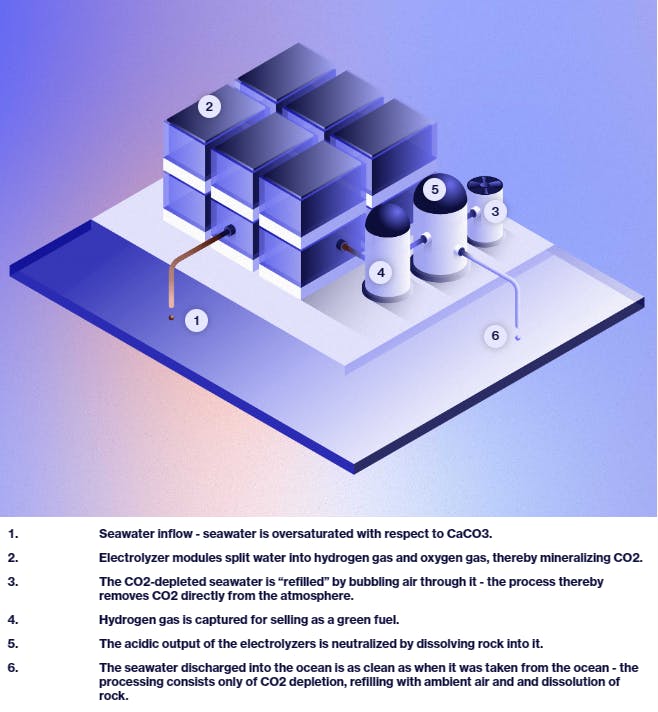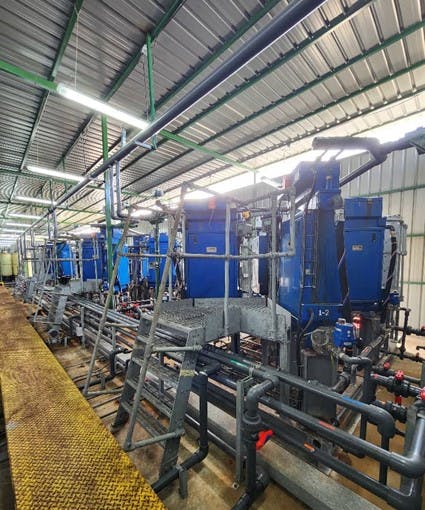Last week, Singapore’s national water agency PUB and US-based start-up Equatic announced that they would be building the world’s largest ocean-based carbon removal plant following a successful pilot.
The US$20 million plant, dubbed Equatic-1, will be able to remove some 3,650 metric tonnes of carbon dioxide (CO2) per year from seawater, or 10 metric tonnes a day.
This is 100 times more than Equatic’s existing pilot plants in Los Angeles and Singapore, each of which have removed 100 kilogrammes of CO2 a day from the ocean since March 2023.
Comparatively, Singapore as a country emitted more than 50 million metric tonnes of CO2 in 2021, more than 13,000 times what the plant aims to remove.
Over the next 18 months, researchers and experts from Equatic and the Institute for Carbon Management at the University of California, Los Angeles (UCLA) will set out to build the plant at PUB’s research and development facility in Tuas, located in western Singapore.
Equatic, formerly known as SeaChange, had in 2021 won S$1 million (US$744,000) via The Liveability Challenge 2021, a global sustainability innovation competition presented by the Temasek Foundation and organised by Eco-Business. The seventh edition of the challenge, which calls for solutions on climate change and food and nutrition to win funding, has attracted a record number of submissions this year.
Equatic co-founder Gaurav Sant, who is also a professor of engineering at UCLA, previously described the technology as working “like a dish sponge” to Eco-Business. This explainer takes a deeper look at the technology, what happens to the stored carbon and other byproducts, and the economics behind the plant.
How does the plant work?
The plant uses a novel electrolytic process developed by scientists at UCLA’s Institute for Carbon Management, several of whom are part of Equatic. Using the company’s oxygen-selective anodes, an electrical current is passed through seawater from PUB’s desalination plants. A series of chemical reactions breaks the water into its carbon-negative hydrogen and oxygen constituents.
At the same time, dissolved and atmospheric CO2 are combined with the calcium and magnesium in the seawater to form solid carbonates, mimicking the natural process of seashell formation.
Before the seawater is then pumped back into the ocean, where it has the capacity to absorb more CO2, its alkalinity is restored by dissolving alkaline rocks prior to discharge.

The diagram shows how Equatic’s novel electrolytic process removes carbon dioxide from seawater. Image: Equatic
What happens to the solid carbonates?
On average, 220 kilogrammes of solid calcium carbonate per day is produced with every tonne of CO2 removed, said the developers. The pilot project produced 22kg of these solids of the 100kg of CO2 produced daily, with the remaining CO2 removed as dissolved magnesium carbonates and bicarbonates.
PUB and Equatic are working with collaborators in Singapore to research possible applications for the solid carbonates. “These solid carbonates could potentially be used in the construction industry for land, restoration, cement, or concrete,” said Dante Simonetti, Equatic Co-Founder and associate professor of chemical and biomolecular engineering at the UCLA Samueli School of Engineering. He is also ICM’s associate director for technology translation.
What happens to the hydrogen produced by the plant?
The plant is expected to produce nearly 300 kilogrammes of carbon-negative hydrogen daily or 105 metric tonnes a year, which can be harnessed as clean energy. Examples of its uses include hydrogen fuel cells, hydrogen turbines for heat and power, as well as hydrogen for storage and distribution.
“For instance, the hydrogen may be used to power the Equatic process, as a clean energy source while simultaneously removing carbon dioxide emissions,” Simonetti told Eco-Business.
How energy intensive is the process?

Equatic’s pilot ocean-based carbon removal project at PUB’s research and development facility in Tuas removed some 100 kilogrammes of carbon dioxide a day. Image: Equatic
The project’s developers are targeting for the process to require less than 2.0 MWh of energy per tonne of CO2 removed, which is just under five times what the average Singaporean household consumed in 2023. “This energy intensity allows for net-negative carbon removal even when using grid energy that incorporates fossil fuels,” Simonetti told Eco-Business.
Is the plant costly to maintain?
The plant’s US$20 million price tag will be covered by PUB, Singapore’s National Research Foundation and UCLA’s Institute for Carbon Management. While the exact cost was not disclosed, Simonetti said that the plant is designed to have similar service commitments and a similar lifespan as analogous industries, such as water treatment, desalination, and water electrolysis for hydrogen generation.
In terms of external weather and climate-related risks, such as rising sea levels or extreme heat, the plant and process in general are designed to be robust, such that they can be incorporated into any infrastructure advancement to combat climate related factors, he said.
Can the plant generate carbon credits?
As the plant is a carbon removal project, its carbon abatement can be represented as carbon credits, allocated to stakeholders based on the proportion of funding. There is currently no set price for the carbon credits as this price varies from region-to-region and market-to-market, said Simonetti.
However, Equatic has plans to scale its technology for commercial use and to generate carbon credits in the future. “When [the Equatic-1 plant] meets its projected carbon-removal goals, we plan to launch commercial plants designed to remove nearly 110,000 metric tonnes of carbon dioxide per year,” he said.
Equatic has entered into agreements with several other companies including aircraft manufacturer Boeing for the purchase of carbon credits from its future commercial plants.





















